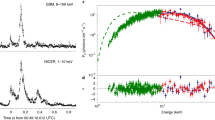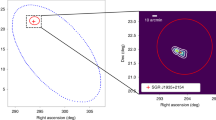Abstract
THE first detection of IR bursts from the object1 known as Liller I which has been identified2 with the rapid X-ray burster MXB1730–333 is reported here. The rapid burster is the only one of its kind that has been extensively studied in the X-ray region3–5 and some of its known characteristics can be summarised as follows. When it is active it gives several thousand X-ray bursts per day. It operates in two modes: mode I (usually in March and September every year), mode II (usually in April and October every year). In mode I it gives large X-ray bursts with energy in the range 1039–1040 erg and also small bursts with energy in the range of 1038–1039 erg; while in mode II it primarily emits bursts with energy typically close to 1039 erg. These bursts are called type II on the basis of the constant character of their spectrum during the decay phase. The rapid burster occasionally also gives bursts known as type I which are characterised by the softening of the X-ray spectrum during the decay phase. The energy in these bursts is usually in excess of 1039 erg and their frequency is about one every few hours.
This is a preview of subscription content, access via your institution
Access options
Subscribe to this journal
Receive 51 print issues and online access
$199.00 per year
only $3.90 per issue
Buy this article
- Purchase on Springer Link
- Instant access to full article PDF
Prices may be subject to local taxes which are calculated during checkout
Similar content being viewed by others
References
Liller, W. Astrophys. J. Lett. 213, L21–L23 (1977).
Doxsey, R. et al. Astrophys. J. Lett. 221, L53–L55 (1978).
Lewin, W. H. G. in Advances in Space Exploration, Vol. 3, (in the press).
Hoffman, J. A., Marshall, H. L. & Lewin, W. H. G. Nature 271, 630–633 (1978).
Marshall, H. L., Ulmer, M. P., Hoffman, J. A., Doty, J. & Lewin, W. H. G. Astrophys. J. 227, 555–562 (1979).
Lewin, W. H. G. IAU Circ. No. 2922 (1976).
Kleinmann, D. E., Kleinmann, S. G. & Wright, E. L. Astrophys. J. Lett. 210, L83–L86 (1976).
Apparao, K. M. V. & Chitre, S. M. Astrophys. Space Sci. (in the press).
Neugebauer, G. & Leighton, R. B. Two-Micron Sky Survey (NASA Sp-3047, 1969).
Author information
Authors and Affiliations
Rights and permissions
About this article
Cite this article
KULKARNI, P., ASHOK, N., APPARAO, K. et al. Discovery of IR bursts from Liller I/MXB1730–333. Nature 280, 819–820 (1979). https://doi.org/10.1038/280819a0
Received:
Accepted:
Issue Date:
DOI: https://doi.org/10.1038/280819a0
This article is cited by
-
SS 433 ? Again
Astrophysics and Space Science (1987)
-
No IR burst during a type I X-ray burst from the rapid burster (MXB1730–335)
Nature (1984)
-
Infrared studies of X-ray sources
Astrophysics and Space Science (1984)
-
X-ray bursters and the x-ray sources of the galactic bulge
Space Science Reviews (1981)
-
Infrared emission from X-ray sources
Astrophysics and Space Science (1981)
Comments
By submitting a comment you agree to abide by our Terms and Community Guidelines. If you find something abusive or that does not comply with our terms or guidelines please flag it as inappropriate.



